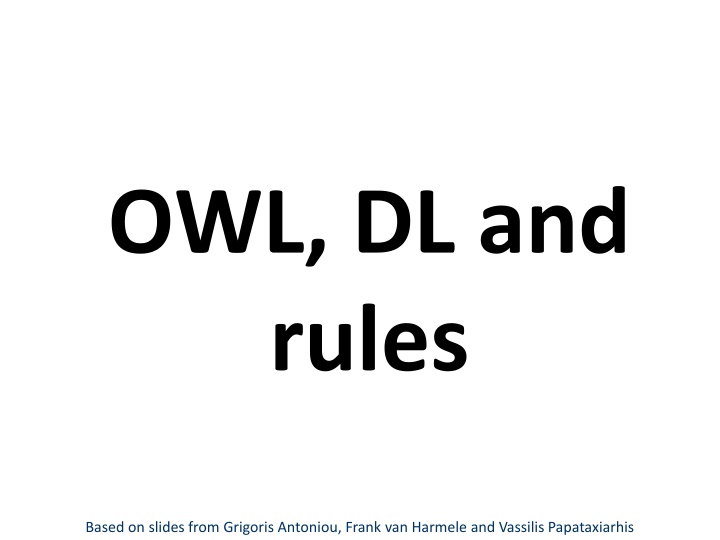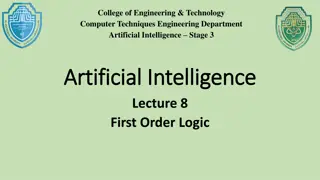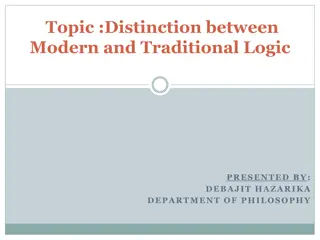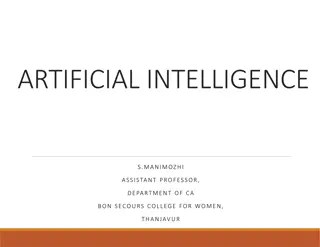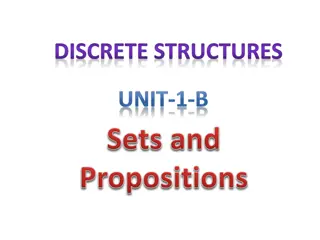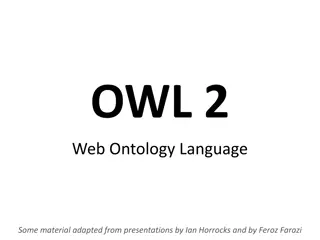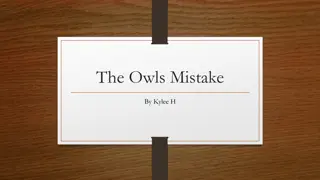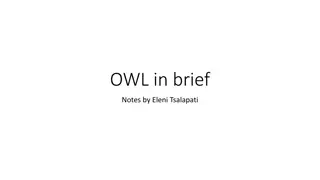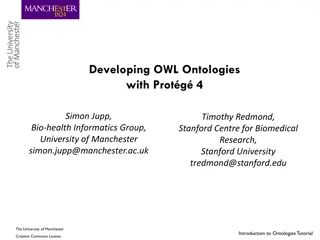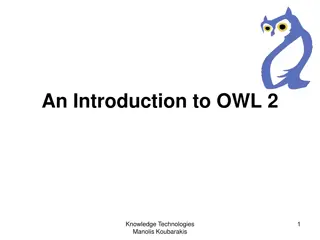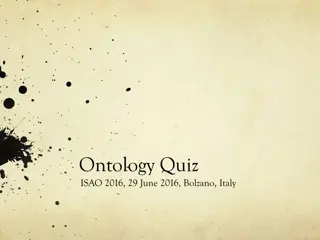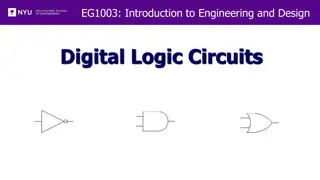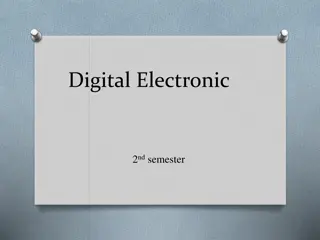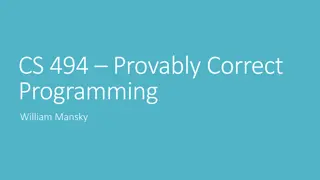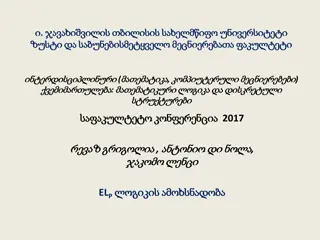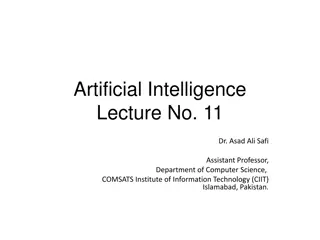OWL, DL, Rules: Representing Knowledge & Logic
Semantic Web is grounded in logic, with various systems like OWL and rules playing crucial roles in representing and reasoning with knowledge. Explore the challenges, approaches, and implications of incorporating rules in OWL, along with the interplay between Description Logics and Horn Logic. Dive into the high expressiveness of rule-based systems and the significance of structure alongside rules in ontology development. Discover the foundations of Horn clause logic and its application in logic-oriented rule languages like Prolog.
Download Presentation

Please find below an Image/Link to download the presentation.
The content on the website is provided AS IS for your information and personal use only. It may not be sold, licensed, or shared on other websites without obtaining consent from the author.If you encounter any issues during the download, it is possible that the publisher has removed the file from their server.
You are allowed to download the files provided on this website for personal or commercial use, subject to the condition that they are used lawfully. All files are the property of their respective owners.
The content on the website is provided AS IS for your information and personal use only. It may not be sold, licensed, or shared on other websites without obtaining consent from the author.
E N D
Presentation Transcript
OWL, DL and rules Based on slides from Grigoris Antoniou, Frank van Harmele and Vassilis Papataxiarhis
OWL and Rules Rule based systems are an important and useful way to represent and reason with knowledge Adding rules to OWL has proved to be fraught with problems We ll look at the underlying issues and two approaches SWRL: a failed standard that is none the less widely used RIF: a successful standard that s not yet widely used
Semantic Web and Logic The Semantic Web is grounded in logic But what logic? OWL Full = Classical first order logic (FOL) OWL-DL = Description logic N3 rules ~= logic programming (LP) rules SWRL ~= DL + LP Other choices are possible, e.g., default logic, fuzzy logic, probabilistic logics, How do these fit together and what are the consequences
We need both structure and rules OWL s ontologies based on DL (and thus in FOL) - The Web is an open environment - Reusability / interoperability - An ontology is a model easy to understand Many rule systems based on logic programming - To achieve decidability, ontology languages don t offer the expressiveness we want. Rules do it well - Efficient reasoning support already exists - Rules are well-known and often more intuitive
A common approach High Expressiveness Rules Layer SWRL Ontology Layer OWL-DL Conceptualization of the domain
Description Logics vs. Horn Logic Neither is a subset of the other Impossible to say that people who study & live in same city are local students in OWL, but can be done using a rule studies(X,Y), lives(X,Z), loc(Y,U), loc(Z,U) localStud(X) Rules cannot assert the information that every person is either a man or a woman This is easily expressed in OWL using disjoint union
Whats Horn clause logic Prolog and most logic -oriented rule languages use horn clause logic Defined by UCLA mathematician Alfred Horn Horn clauses are a subset of FOL where every sentence is a disjunction of literals (atoms) where at most one is positive ~P V ~Q V ~R V S ~P V ~Q V ~R Atoms are propositional variables (isRaining) or predicates ( married(alice, ?x))
An alternate formulation Horn clauses can be re-written using the implication operator ~P V Q = P Q ~P V ~Q V R = P Q R ~P V ~Q = P Q What we end up with is ~ pure prolog Single positive atom as the rule conclusion Conjunction of positive atoms as the rule antecedents (conditions) No not operator Atoms can be predicates (e.g., mother(X,Y))
Where are the quantifiers? Quantifiers (forall, exists) are implicit Variables in rule head (i.e., conclusion or consequent) are universally quantified Variables only in rule body (i.e., condition or antecedent) are existentially quantified Example: isParent(X) hasChild(X,Y) forAll X: isParent(X) if Exisits Y: hasChild(X,Y)
We can relax this a bit Head can contain a conjunction of atoms P Q R is equivalent to P R and Q R Body can have disjunctions P R Q is equivalent to P R and P Q But something are just not allowed: No disjunction in head No negation operator, i.e. NOT
Facts & rule conclusions are definite Definite means not a disjunction Facts are rule with the trivial true condition Consider these true facts: P Q # either P or Q (or both) are true P R # if P is true, then R is true Q R # if Q is true, then R is true What can you conclude? Can this be expressed in horn logic?
Facts & rule conclusions are definite Consider these true facts where not is classical negation rather than negation as failure not(P) Q, not(Q) P # i.e. P Q P R, Q R A horn clause reasoner can t prove that either P or Q is necessarily true or false so can t show that R must be true Treating not as negation as failure yields a loop
Non-ground entailment The LP-semantics is defined in terms of minimal Herbrand model, i.e., sets of ground facts Because of this, Horn clause reasoners can not derive rules, so that can not do general subsumption reasoning
Decidability The largest obstacle! Tradeoff between expressiveness and decidability Facing decidability issues from In LP: Finiteness of the domain In classical logic (and thus in DL ): combination of constructs Problem: Combination of simple DLs and Horn Logic are undecidable. (Levy & Rousset, 1998)
Homogeneous Approach Interaction with tight semantic integration Both ontologies and rules are embedding in a common logical language No distinction between rule predicates and ontology predicates Rules may be used for defining classes and properties of the ontology Example: SWRL, DLP Ontologies Rules RDFS
Hybrid Approach Integration with strict semantic separation between the two layers Ontology used to conceptualize the domain Rules can t define ontology classes & properties, but some application-specific relations Communication via a safe interface Example: answer set programming (ASP) ? Ontologies Rules RDFS
SWRL Semantic Web Rule Language SWRL is the union of DL and horn logic + many built-in functions (e.g., math) Submitted to the W3C in 2004, but failed to become a recommendation W3C pursued a more general solution: RIF Problem: full SWRL specification leads to undecidability in reasoning SWRL is well specified and subsets are widely supported (e.g., in Pellet, HermiT)
SWRL OWL classes are unary predicates, properties are binary ones Person(?p) ^ sibling(?p,?s) ^ Man(?s) brother(?p,?s) As in Prolog, bulit-ins can be booleans or do a computation and unify the result to a variable swrlb:greaterThan(?age2, ?age1) # age2>age1 swrlb:subtract(?n1,?n2,?diff) # diff=n1-n2 SWRL predicates for OWL axioms and data tests differentFrom(?x, ?y), sameAs(?x, ?y), xsd:int(?x), [3, 4, 5](?x),
SWRL in Protege Prot g 4.x has minimal support for SWRL Can add/edit rules, some reasoners (Pellet, HermiT) use them Reasoning (Fwd Chaining) New Facts Jess Rule Engine Rules Facts Convert to Jess Syntax Prot g 3.x has Jess, an internal rules engine Jess is a production rule system with a long ancestry Convert to OWL Syntax Rule Base (SWRL) Rules Ontology Base (OWL) Prot g And good tools for editing, managing and using rules Prop. Class Individual Reasoning (Subsumption, Classification) See the SWRL tab SWRL architecture for Prot g 3.x
The Essence of SWRL Combines OWL DL (and thus OWL Lite) with function-free Horn logic Thus it allows Horn-like rules to be combined with OWL DL ontologies
Rules in SWRL B1, . . . , Bn A1, . . . , Am A1, . . . , Am, B1, . . . , Bn have one of the forms: C(x) P(x,y) sameAs(x,y) differentFrom(x,y) where C is an OWL description, P is an OWL property, and x,y are variables, OWL individuals or OWL data values.
Drawbacks of SWRL Main source of complexity: arbitrary OWL expressions, such as restrictions, can appear in the head or body of a rule Adds significant expressive power to OWL, but causes undecidability there is no inference engine that draws exactly the same conclusions as the SWRL semantics
SWRL Sublanguages SWRL adds the expressivity of DLs and function-free rules One challenge: identify sublanguages of SWRL with right balance between expressivity and computational viability A candidate OWL DL + DL-safe rules every variable must appear in a non- description logic atom in the rule body
DL-safe rules (all?) reasoners support only DL-safe rules Rule variables bind only to known individuals Example (mixing syntaxes): :Vehicle(?v) ^ :Motor(?m) ^ :hasMotor(?v,?m) -> :MotorVehicle(?v) :Car = :Vehicle and some hasMotor Motor :x a :Car The reasoner will not bind ?m to a motor since it is not a known individual
Protg 3.x had SWRL-Tab Good support for creating and editing SWRL rules
Protg 4.3 bare-bones SWRL support Simple interface to add and edit SWLR rules
SWRL limitations SWRL rules do not support many useful features of of some rule-based systems Default reasoning Rule priorities Negation as failure (e.g., for closed-world semantics) Data structures The limitations gave rise to RIF
Summary Horn logic is a subset of predicate logic that allows efficient reasoning, orthogonal to description logics Horn logic is the basis of monotonic rules DLP and SWRL are two important ways of combining OWL with Horn rules. DLP is essentially the intersection of OWL and Horn logic SWRL is a much richer language
Summary (2) Nonmonotonic rules are useful in situations where the available information is incomplete They are rules that may be overridden by contrary evidence Priorities are sometimes used to resolve some conflicts between rules Representation XML-like languages is straightforward
